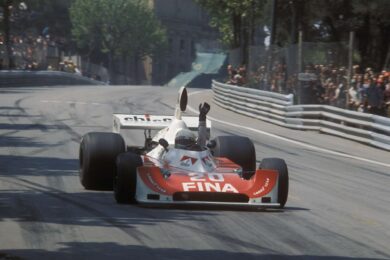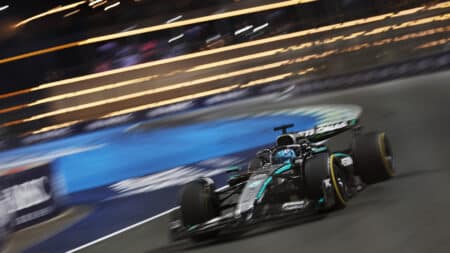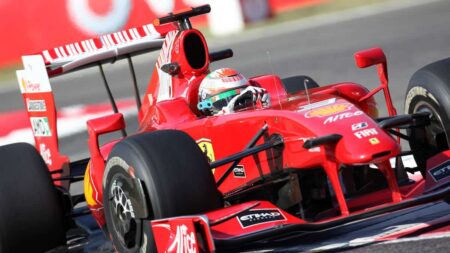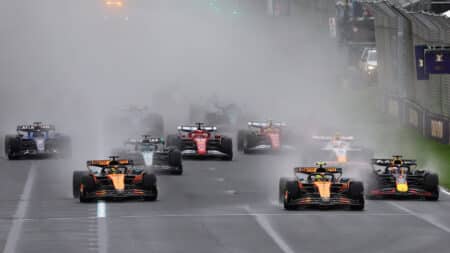
Paradise lost: Montjuïc and the 1975 Spanish Grand Prix
Try to imagine your ideal street track, and the only limits are your imagination. It would be fast and challenging; a touch daunting. It would have sharp gradient changes –…
Between November 29 and January 3, we’ll be reviewing the 2012 motor sport season month by month. Along with these features, Ed Foster will be assessing each Formula 1 team’s performance, starting with HRT. There will be galleries, competitions and Nigel Roebuck’s top 10 drivers. Finally, in the run-up to Christmas, each of our writers will talk about their highlight of the year, so keep checking back every day. This time we look at September.
Formula 1
The Japanese Grand Prix looked like a done deal at the end of qualifying, Sebastian Vettel taking pole position with team-mate Webber behind. Barring another alternator failure, the possibility of another 2011-style pole-to-flag victory was strong. Heading into the first corner, Alonso made his first real mistake of the season, clipping Kimi Räikkönen and spinning in the field. His race ended then and there.
Vettel was a worthy winner but the real story was who joined him on the podium. In second was Felipe Massa, his best finish since the controversial German Grand Prix in 2010 when he was asked to move over for Alonso. Third was Sauber’s Kamui Kobayashi, scoring his first podium finish at home. In the standings, Vettel had now closed to within four points of Alonso.
In Korea, the Red Bulls were on dominant form again, with a Webber-Vettel front row converted somewhat inevitably to a Vettel-Webber finish. The Ferraris followed them home but never really posed a threat to Vettel; Alonso was now in full damage limitation mode. He had lost the championship lead for the first time in eight races.
In India, Vettel took an incredible fourth consecutive victory, followed in second by Alonso, valiantly clinging to his chance at the title. After the early-season confusion over tyre strategy and which cars would be competitive week in and week out, everything seemed to have settled down.
World Endurance Championship
Bearing in mind they had only entered the championship at the third round at Le Mans, Toyota had made a huge impact on sports car racing. They may not have stood a realistic chance of challenging Audi for the WEC, but after the Fuji and Shanghai rounds they had won three out of the six races they entered.
At Fuji, Kazuki Nakajima was back in the car with Alex Wurz and Nicolas Lapierre, giving him the chance to win his home race. After Kobayashi’s home podium at Suzuka and Takuma Sato’s nearly-man performance at the Indy 500 it was a year to remember for Japanese racing fans.
André Lotterer, Benoît Tréluyer and Marcel Fässler’s third place at Shanghai was enough to clinch the title over team-mates Allan McNish and Tom Kristensen. The excitement for 2013 was palpable; Peugeot may have left the sport, but Toyota had more than made up for it.
World Rally Championship
Sébastien Loeb clinched his ninth consecutive World Rally Championship in France, having won eight out of 11 rounds of the year thus far. Jari-Matti Latvala followed in second with Loeb’s Citroën team-mate Mikko Hirvonen in third.
The Finn had finished on the podium eight times and it was his turn to finally win in Italy after Loeb’s retirement. The Ford pair of Evgeny Novikov and Ott Tänak completed the top three.
MotoGP
In Japan and Malaysia, there were two Pedrosa-Lorenzo top two finishes; Casey Stoner was back but well out of the title battle by now.
That didn’t stop him winning his home Grand Prix in Australia, a fitting last win for his short but sweet career. Lorenzo again finished second with Cal Crutchlow making it onto the podium for the second time on his Tech 3 Yamaha.
Dani Pedrosa retired, crashing out from the lead on only the second lap. Lorenzo was champion for a second time and the consensus was that he was a much more mature rider than two years ago. When he didn’t win, he finished second (barring retirements) and no lower. Despite the efforts of Pedrosa and Stoner, he was untouchable all year long.
What we had to say
Paul Fearnley rated Hamilton’s move from McLaren to Mercedes:
“Even though the team’s atmosphere has lightened with Martin Whitmarsh’s hand upon its tiller, it could not keep pace with its star pupil’s transformation. Hamilton, so fresh-faced that I’m jolted whenever I double-check his age, is a changed man…”
Gordon Kirby paid tribute to the late Chris Economaki:
“He was able to move effortlessly from Formula 1 to NASCAR, midget and sprint car racing, Indycar racing, drag racing and every form of short track oval racing. A mention in Economaki’s column could make and sometimes break a career in the sport.”
Nigel Roebuck commented on racing’s expert blockers:
“Giuseppe Farina had done it without a thought – but then this was the same man who had impatiently turfed Marcel Lehoux’s ERA off the road, while lapping it en route to victory in the one-off Deauville Grand Prix in 1936. Lehoux was killed.”
We also had Tiff Needell in for a podcast and he proved to be very entertaining. Later on in the month we recorded our readers’ evening with 1964 World Champion John Surtees.
What you had to say
John Read commented on Ferrari’s driver dilemma:
“From a pragmatic point of view, any team striving for the drivers’ title should have a clear number one and a fast, compliant number two.”
Russ lamented the state of American racing:
“Racing in America is in danger of becoming irrelevant on the international scene. The lure of success in NASCAR attracts most upcoming young drivers these days. And while that sport itself is fading both in terms of viewers and attendees at the races they have enough accumulated cash to buy the major road racing series.”
Aaron Rowles enjoyed seeing Jorge Lorenzo win the MotoGP title:
“There is a perfect simplicity to the way Jorge rides. Whilst many didn’t ‘like’ him for beating Rossi in the same machine, few can argue that Lorenzo isn’t an exceptional talent. Maybe not the fastest over one lap, but he can hit the same lap time and the same lines perfectly lap after lap; it’s perfection.

Try to imagine your ideal street track, and the only limits are your imagination. It would be fast and challenging; a touch daunting. It would have sharp gradient changes –…

Fears that one engine manufacturer will dominate F1 from 2026 are likely to see strugglers allowed to catch up. If power units are to be artificially equalised, how much of a technical competition will it be? asks Mark Hughes

For an Italian F1 driver, few roles are more coveted than a Ferrari race seat, but Giancarlo Fisichella had the misfortune of joining the team during a testing 2009 season

F1 moves closer to changing its rules in a bid to avoid one engine manufacturer dominating for years, and looks to spark out the grass fires that plagued Suzuka